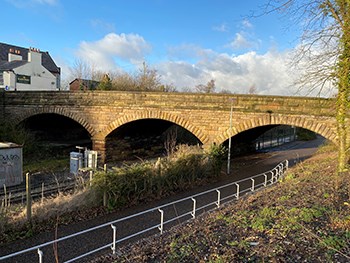Derby Street Railway Bridge - Safety improvements and major maintenance
Lancashire County Council is preparing to carry out vital safety improvements to Derby Street Bridge, which is located in Ormskirk town centre, and carries the A570 over the railway line which links Preston and Liverpool.
Derby Street Bridge was built in 1848, and was not designed to carry modern traffic. Work is now needed to make it safer and strengthen the bridge. The current footways on the bridge are too narrow for pedestrians to use safely, and the narrow traffic lanes increase the risk of a collision which could impact the bridge and affect the safety of the railway which runs underneath.
Planned work
- The footways will be widened to make the bridge safer for pedestrians and the carriageway will be reduced from two lanes to one for traffic from the traffic lights at the junction with Burscough Street. Traffic from Railway Road and Railway Approach will join Derby Street by merging into the single lane across the bridge.
This will also move traffic away from the parapet walls of the bridge, reducing the risk of a vehicle colliding with the wall and endangering the railway.
- The bridge will be fitted with heritage railings in keeping with the historic appearance of the bridge. These are needed as the parapet walls are currently lower than standard, and the railings will make it safer for pedestrians to use.
- Maintenance is needed to the bridge arches to ensure it is strong enough to withstand the weight of traffic using the A570. The arches on the bridge are made up of several connected brick rings. Investigations have shown that the mortar which connects the rings has broken down and the rings are no longer supporting each other as they should. To restore the arches the brick rings will be stitched together from underneath using steel ties.
How we know that reducing traffic to one lane will not cause delays
The proposal is based on detailed traffic modelling, a tried and tested method of testing what impact any change to the roads will have on traffic.
A computer-based model has been produced using real-life traffic surveys and information captured by cameras which monitor traffic levels on the bridge and in the surrounding area.
This comprehensive set of information has been used to provide a robust assessment of the impacts on the area being modelled, together with any knock-on effects on roads across the wider area. This work resulted in a simulation of the way traffic uses the area to show real-time traffic movements.
This showed that any impact on traffic by reducing the bridge to one lane would be very minor and would not have a significant impact on traffic as it crosses the bridge, or at junctions in the surrounding area.
Testing the impact of reducing the bridge to one lane
A trial or pilot scheme would only provide a snapshot of the impact at the time, and can be influenced by other factors – such as traffic being quieter than normal, or an incident nearby causing more traffic. It is therefore not as reliable as producing a computer model using survey data collected over an extended period of time.
However, we have recently observed the bridge operating with a single traffic lane during recent work to take 'core samples', as part of our preparations for the maintenance scheme, including during the morning and evening 'peak hour' for traffic, and were able to see that traffic flowed freely over the bridge as predicted by our previous traffic modelling work.
Cost
The estimated project cost for delivery of the works is £2m. This represents a significant investment in the Ormskirk transport system and will ensure that the bridge is safe for use by all and that it will continue to remain an important feature of the Ormskirk town centre conservation area.
How long it will take and how it will be done
The work is currently planned to take place in 3 phases over an 8-month period. Some of the work will take place from underneath the bridge so this will not involve any changes to the road above.
The road will stay open to traffic throughout the work with a single lane during the day. There will be some limited overnight closures to carry out work that cannot be done while the road is open.
